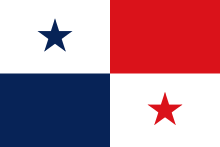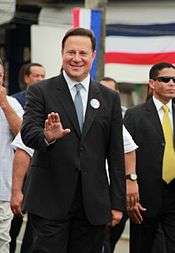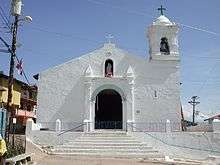Panamanians
Panamanians (Spanish: Panameños) are people identified with Panama, a country in Central America, whose connection may be residential, legal, historical, or cultural. For most Panamanians, several or all of these connections exist and are collectively the source of their Panamanian identity. Panama is a multilingual and multicultural society, home to people of many different ethnicities and religions. Therefore, many Panamanians do not equate their nationality with ethnicity, but with citizenship and allegiance to Panama. The overwhelming majority of Panamanians are the product of varying degrees of admixture between European ethnic groups (predominantly Spaniards) with native Amerindians who are indigenous to Panama's modern territory.
 | |
| Total population | |
|---|---|
| c. 4–4.5 million (worldwide) | |
| Regions with significant populations | |
| 183,743[2] | |
| 16,947[3] | |
| 4,000[4] | |
| 850[5] | |
| Languages | |
| Panamanian Spanish (predominantly) Guaymí and other Amerindian languages | |
| Religion | |
| Predominantly Roman Catholicism[6] Judaism, Protestantism, Santería, Baha'i | |
| Related ethnic groups | |
| Other Latin Americans and Amerindians | |
The culture held in common by most Panamanians is referred to as mainstream Panamanian culture, a culture largely derived from the traditions of the Indigenous people and the early Spanish settlers, along with other Europeans arriving later such as Italians, with west African culture as another important component.
Culture
The culture of Panama derived from the cultures of Indigenous peoples of Panama, art and traditions, as well as African Culture that were brought over by the Spanish to Panama. Hegemonic forces have created hybrid forms of this by blending African and Native American culture with European culture. For example, the tamborito is a Spanish dance with that was blended with Native American rhythms and dance moves. Dance is a symbol of the diverse cultures that have coupled in Panama. The culture, customs, and language of the Panamanians are predominantly Caribbean and Spanish.
Ethnic groups
Ethnic Groups in Panama %[7]
| Population of Panama according to ethnic group [8] | ||||||
| Ethnic group |
Census 1990 | Census 2000 | Census 2010 | |||
|---|---|---|---|---|---|---|
| Number | % | Number | % | Number | % | |
| Non-indigenous | 2,135,060 | 91.7 | 2,553,946 | 90.0 | 2,988,254 | 87.7 |
| Amerindian | 194,269 | 8.3 | 285,231 | 10.0 | 417,559 | 12.3 |
| Total | 2,329,329 | 2,839,177 | 3,405,813 | |||
Mestizo
Mestizo Panamanians are Panamanian people who are of mixed of both European and indigenous ancestry. Mestizos are the majority in Panama, accounting for 70% of the country's population.
Amerindian
| Indigenous population of Panama by ethnic group [8] | ||||||
| Ethnic group |
Census 1990 | Census 2000 | Census 2010 | |||
|---|---|---|---|---|---|---|
| Number | % | Number | % | Number | % | |
| Ngäbe (Guaymi) | 123,626 | 63.6 | 169,130 | 59.3 | 260,058 | 62.3 |
| Buglé (Bokota) | 3,784 | 1.9 | 18,724 | 6.6 | 26,871 | 6.4 |
| Kuna | 47,298 | 24.3 | 61,707 | 21.6 | 80,526 | 19.3 |
| Emberá | 14,659 | 7.5 | 22,485 | 7.9 | 31,284 | 7.5 |
| Wounaan | 2,605 | 1.3 | 6,882 | 2.4 | 7,279 | 1.7 |
| Teribe/Naso | 2,194 | 1.1 | 3,305 | 1.2 | 4,046 | 1.0 |
| Bribri | 2,521 | 0.9 | 1,068 | 0.3 | ||
| Other | 103 | 0.1 | 460 | 0.1 | ||
| Not declared | 477 | 0.2 | 5,967 | 1.4 | ||
Black
Afro-Panamanians played a significant role in the creation of the republic. The descendants of the Africans who arrived during the colonial era are intermixed in the general population or live in small Afro-Panamanian communities along the Atlantic Coast and in villages within the Darién jungle. Most of the people in Darien are fishermen or small-scale farmers growing crops such as bananas, rice and coffee as well as raising livestock. Other Afro-Panamanians descend from later migrants from the Caribbean who came to work on railroad-construction projects, commercial agricultural enterprises, and (especially) the canal. Important Afro-Caribbean community areas include towns and cities such as Colón, Cristobal and Balboa, in the former Canal Zone, as well as the Río Abajo area of Panama City. Another region with a large Afro-Caribbean population is the province of Bocas del Toro on the Caribbean coast just south of Costa Rica.[9]
Most of the Panamanian population of West Indian descent owe their presence in the country to the monumental efforts to build the Panama Canal in the late 19th and early 20th centuries. Three-quarters of the 50,000 workers who built the canal were Afro Caribbean migrants from the British West Indies. Thousands of Afro-Caribbean workers were recruited from Jamaica, Barbados and Trinidad.[9]
White

White Panamanians form 6.7%,[10] with the majority being of Spanish descent. Other ancestries includes Dutch, English, French, German, Swiss, Danish, Irish, Greek, Italian, Lebanese, Portuguese, Polish, Russian and Ukrainian. There is also a sizable and very influential Jewish community.
Asian
Panama, partly owing to its historical reliance on commerce, is an ethnically diverse society. It has considerable populations of Afro-Antillean and Chinese origin. The first Chinese immigrated to Panama from southern China to help build the Panama Railroad in the 19th century. There followed several waves of immigrants whose descendants number around 50,000. Starting in the 1970s, a further 80,000 have immigrated from other parts of China as well.[11][12]
Languages
Spanish is the official and dominant language. About 93% of the population speak Spanish as their first language, though many citizens speak both English and Spanish or native languages, such as Ngäbere. Many languages, including seven indigenous languages, are spoken in Panama, although Spanish is the official and dominant language. English is sometimes spoken by many professionals and those working in the business or governmental sectors of society.
Religion

The government of Panama does not collect statistics on the religious affiliation of citizens, but various sources estimate that 75 to 85 percent of the population identifies itself as Roman Catholic and 15 to 25 percent as evangelical Christian.[14] The Bahá'í Faith community of Panama is estimated at 2.00% of the national population, or about 60,000[15] including about 10% of the Guaymí population;[16] the Bahá'ís maintain one of the world's eight Baha'i Houses of Worship in Panama.[14]
References
- File POP/1-1: Total population (both sexes combined) by major area, region and country, annually for 1950–2100 (thousands). World Population Prospects: The 2015 Revision (Report). United Nations, Department of Economic and Social Affairs, Population Division. April 2016. Archived from the original on 22 December 2015. Retrieved 17 December 2015.
- US Census Bureau 2012 American Community Survey B03001 1-Year Estimates HISPANIC OR LATINO ORIGIN BY SPECIFIC ORIGIN retrieved September 20, 2013
- El perfil de la población de origen centroamericano y del Caribe en Estados Unidos (in spanish) Page 32/53: La migración internacional de panameños es relativamente reducida en su número absoluto y con relación a la población total de ese país. En 2010 el 69.7% de dichos inmigrantes se ubicaron en Estados Unidos y un 11.9% adicional en Costa Rica.
- "Immigrant and Emigrant Populations by Country of Origin and Destination". migrationpolicy.org. February 10, 2014.
- "Panamá - Emigrantes totales 2019". datosmacro.com.
- The Latin American Socio-Religious Studies Program / Programa Latinoamericano de Estudios Sociorreligiosos (PROLADES) PROLADES Religion in America by country
- "CIA - The World Factbook -- Panama". CIA. Archived from the original on 22 August 2013. Retrieved 2013-10-07.
- Instituto Nacional de Estadistica y Censo (INEC)
- "Panama : Afro-Panamanians". Minority Rights Group International. Archived from the original on December 3, 2012. Retrieved June 26, 2010.
- "Panama; People; Ethnic groups". CIA World Factbook. Retrieved 2007-11-21.
- Jackson, Eric (May 2004). "Panama's Chinese community celebrates a birthday, meets new challenges". The Panama News. 10 (9). Archived from the original on September 16, 2007. Retrieved November 7, 2007.
- "President Chen's State Visit to Panama". Government Information Office, Republic of China. October 2003. Archived from the original on August 14, 2007. Retrieved November 7, 2007.
- Katzman, Patricia. Panama. Hunter Publishing (2005), p106. ISBN 1-58843-529-6.
- International Religious Freedom Report 2007: Panama. United States Bureau of Democracy, Human Rights and Labor (September 14, 2007). This article incorporates text from this source, which is in the public domain.
- "Panama". WCC > Member churches > Regions > Latin America > Panama. World Council of Churches. 2006-01-01. Archived from the original on 2008-07-08. Retrieved 2008-07-01.
- International Community, Bahá'í (October–December 1994). "In Panama, some Guaymis blaze a new path". One Country. 1994 (October–December). Archived from the original on 2014-08-02. Retrieved 2015-01-05.


.svg.png)